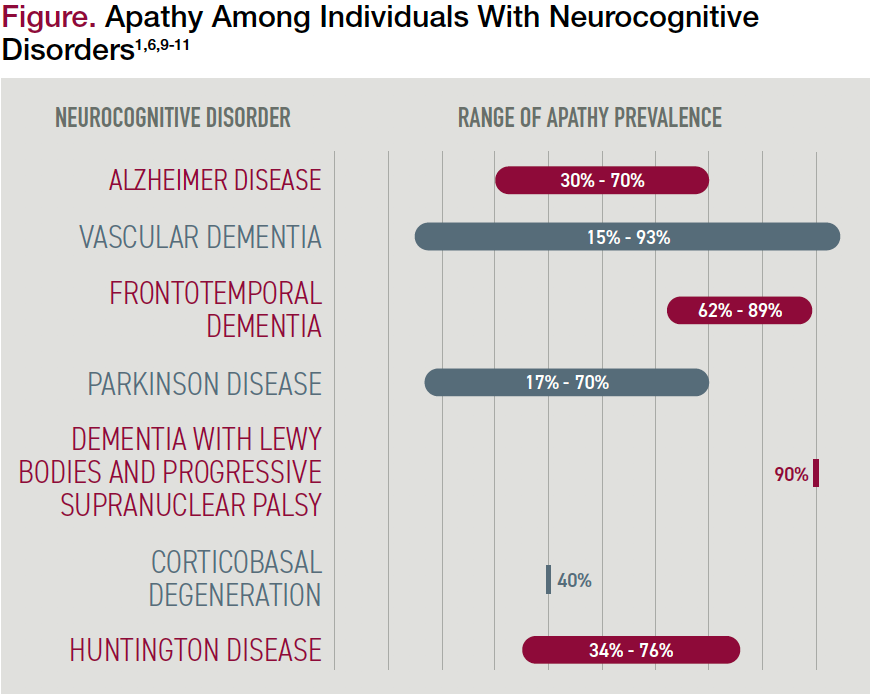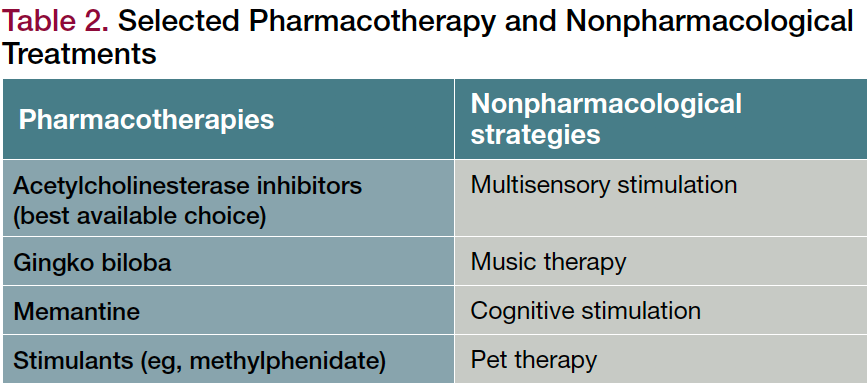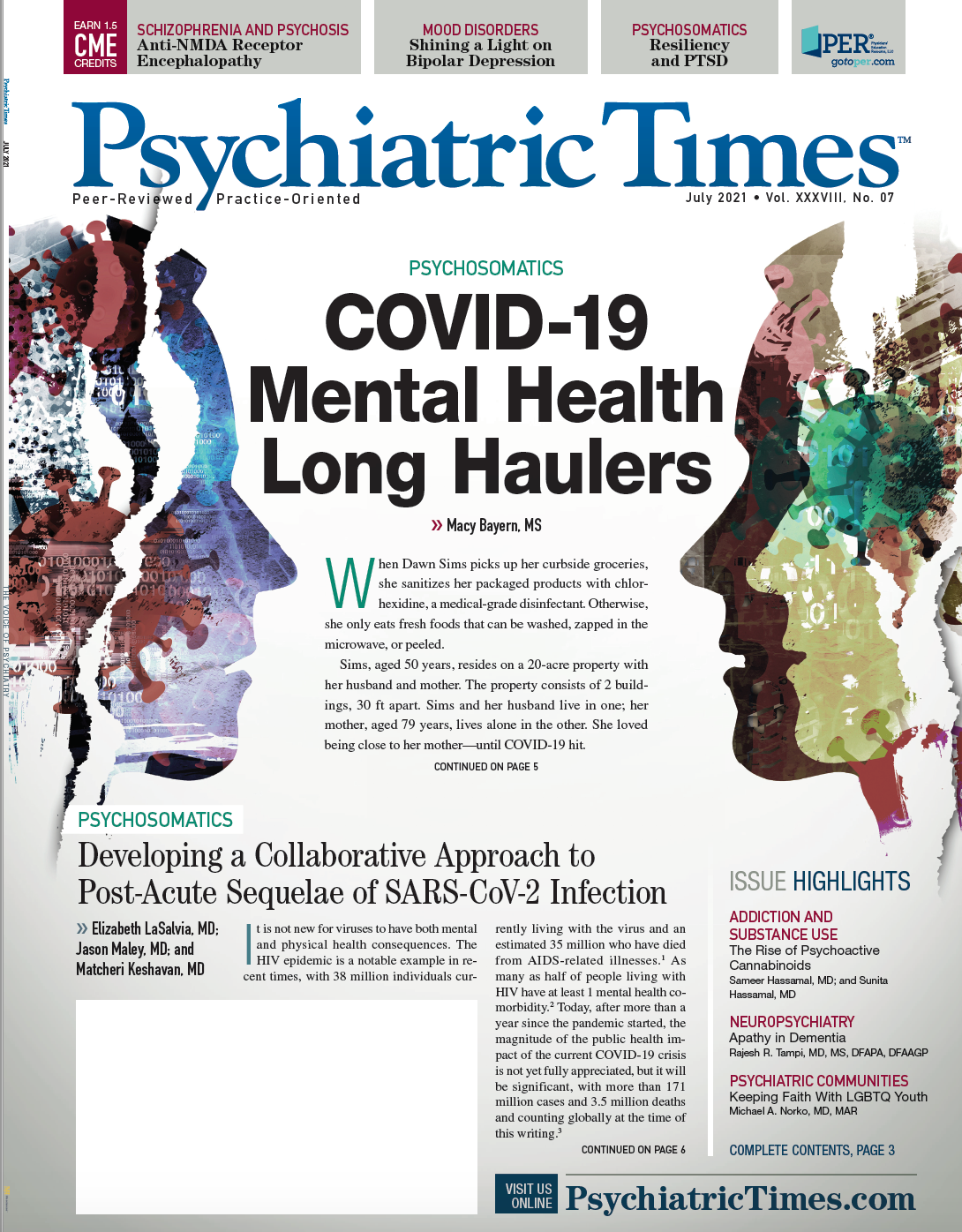News
Article
Psychiatric Times
Addressing Apathy in Dementia
Author(s):
Apathy occurs throughout the spectrum of neurocognitive disorders, but it is easy to mistake for other conditions, like depression. How can clinicians identify apathy, and treat it?
Photographee.eu/AdobeStock

The English word apathy originates from the Greek word apathes, which means “without pathos or feeling,”1 but scholars have shared various definitions. For example, Robert S. Martin, MD, defined apathy as a syndrome of primary motivational loss that is not attributable to emotional distress, intellectual impairment, or diminished level of consciousness.2 According to Drs Richard Levy and Bruno Dubois apathy is the quantitative reduction of self-generated voluntary and purposeful behaviors, which are observable and can be quantified.3 In addition, the underlying mechanism(s) responsible for apathy may be seen as dysfunctions occurring at the level of elaboration, execution, and control of goal-directed behaviors. According to an international consensus criterion, apathy is defined as a disorder of motivation in which the symptoms are present for at least 4 weeks.4 In addition, 2 of the following 3 should be present: reduced goal-directed behavior, reduced goal-directed cognitive activity, and reduced emotions. Furthermore, these symptoms cause clinically significant impairments in personal, social, occupational, or other important areas of functioning, with such symptoms not exclusively explained by or due to other causes (ie, physical disabilities [such as blindness or loss of hearing], motor disabilities, diminished level of consciousness, or direct physiological effects of a substance [such as a drug of abuse or a medication]).
Epidemiology
Rajesh R. Tampi, MD, MS, DFAPA

Apathy is seen in approximately 1.4% to 15.8% of individuals who have no cognitive deficits.5 It is also seen among individuals with major depressive disorder, schizophrenia, strokes, multiple sclerosis, and traumatic brain injury. Apathy is more prevalent among individuals with neurodegenerative disorders than in those free of such disorders.6
Apathy has been noted throughout the spectrum of neurocognitive disorders (Figure).1,6,7,9-11 The prevalence rates for apathy among individuals with mild cognitive impairment ranges from 3.1% to 50.5%.8 Apathy is also the most frequently reported behavioral symptom among individuals with dementia. The results of one study showed that individuals with frontotemporal dementia (FTD) and vascular dementia (VaD) report more severe apathy than individuals with Alzheimer disease (AD).12
Apathy Among Individuals With Neurocognitive Disorders

Apathy usually appears early in dementia and tends to persist throughout; it is associated with longer illness duration and it worsens with the progression of dementia.9 Risk factors for developing apathy include older age and greater severity of cognitive impairment. Akyol et al found that apathy was correlated with the degree of cognitive impairment among individuals with AD and VaD, but not with FTD; but apathy did not correlate with age or gender in individuals with AD, FTD, and VaD. Additionally, the degree of apathy correlated with the level of functional impairment and dementia severity across all 3 types of dementia.12
Individuals with dementia who present with apathy often have more rapid cognitive decline and are more impaired in their activities of daily living.1 In addition, apathy increases the risk for earlier institutionalization among individuals with dementia.9 Distress is also significantly higher among caregivers of individuals with dementia who have apathy, when compared with individuals with dementia without it.1 Apathy is also associated with increased risk for death among individuals with dementia.13
Neurobiology
Emerging evidence indicates that apathy in individuals with dementia occurs due to a complex interaction among neuroanatomy, neuropathology, neurochemistry, and genetics.7 Among individuals with AD, apathy is associated with an increased neurofibrillary tangle burden in the parahippocampal, frontal, and parietal regions, in addition to the anterior cingulate gyrus. Emerging evidence indicates that the severity of apathy is also associated with amyloid plaque burden, especially in bilateral frontal cortices and the right anterior cingulate gyrus along with other cortical areas of the brain.14,15
One study that evaluated the cerebrospinal fluid (CSF) biomarkers among individuals with AD showed that apathy was significantly correlated with tau and p-tau, but not with amyloid β١–٤٢.16 Another study examined regions of cortical thinning and CSF biomarkers (amyloid-β ١-٤٢, total tau, and phosphorylated tau) among 3 groups—clinically normal elderly individuals, individuals with mild cognitive impairment, and individuals with mild AD dementia with apathy—and found that reduced baseline inferior temporal cortical thickness was predictive of increasing apathy over time.17 The investigators of this study did not find any association between CSF biomarkers and the severity of apathy in cross-sectional or longitudinal analyses.
Another study found that individuals with AD and apathy had a loss of white matter integrity in the genu of the corpus callosum when compared with individuals with AD without apathy.18 In addition, the loss of white matter integrity in the genu, body, and splenium of the corpus callosum was negatively correlated with the severity of apathy among individuals with AD. Neuroradiological studies indicate that the dysfunction of the anterior cingulate cortex is the strongest anatomical correlate of apathy in AD, whereas lesions of the basal ganglia are the most common correlates of apathy in cerebrovascular disorders.19
Neuroimaging studies indicate that the apathy among individuals with behavioral variant of FTD is associated with prominent atrophy in: the dorsal anterior cingulate cortex, dorsolateral prefrontal cortex, right caudate (including the ventral striatum), right temporoparietal junction, right posterior inferior and middle temporal gyri, and left frontal operculum-anterior insula region.20,21
A recent meta-analysis that analyzed data from 41 studies indicated that apathy is associated with hypometabolism and a decrease in gray matter volume in the left inferior frontal gyrus.22 The investigators also found altered brain perfusion and decreased gray matter volume in the anterior cingulate cortex among individuals with AD, and decreased gray matter volume in the inferior frontal gyrus and parietal cortex among individuals with FTD. These findings indicate that apathy occurs due to a cortical dysfunction of areas involved with executive cognitive processing (action planning) and emotional regulation (autoactivation and reward processing).
Individuals with AD and apathy have been found to have reduced dopaminergic activity in the putamen, reduced acetylcholine in the lateral frontal cortex, and lower levels of plasma gamma-aminobutyric acid.7 In evaluating the association between apolipoprotein E ɛ4 allele and apathy in probable AD, investigators found that the presence of this allele was indeed significantly associated with apathy in these individuals.
Assessment
Among individuals with dementia, the assessment of apathy is often complicated. It is particularly difficult to distinguish between reduced motivation to do things due to apathy and the loss of ability or motivation secondary to cognitive dysfunction. Additionally, there may be overlap between symptoms of apathy and depression (Table 1).7 Often, as well, psychotropic medications (ie, antipsychotics, antidepressants) are used to treat neuropsychiatric symptoms (NPS) of dementia, and the adverse effects of these medications include fatigue, lethargy, listlessness, and decreased initiative to respond to external stimuli. These AEs can mimic symptoms of apathy among individuals with dementia.1
Distinguishing Depression from Apathy

The scales that have been developed for the assessment of apathy include the Apathy Evaluation Scale (AES), the Structured Clinical Interview for Apathy, the Apathy Scale, the Apathy Inventory, the Dementia Apathy Interview and Rating (DAIR), and the Lille Apathy Rating Scale (LARS).7 Among these scales, only the DAIR was designed for use among individuals with dementia. The Apathy Scale for Dementia Patients in Nursing Homes was designed to measure apathy among individuals with dementia who live in institutional settings.23 The Neuropsychiatric Inventory (NPI) is considered the gold standard for the assessment of NPS among individuals with dementia. However, the use of a single domain from the NPS prevents a comprehensive assessment of all dimensions of apathy among individuals with dementia. A recent systematic review found that the DAIR, the AES–clinical version (AES-C) in AD, and the LARS in Parkinson disease (PD) had psychometrically favorable qualities and the highest quality among the scales used to assess apathy among individuals with neurodegenerative disorders.24
Treatments
Available evidence indicates that both nonpharmacological and pharmacological treatment modalities can benefit individuals with dementia who present with apathy (Table 2).1
Selected Pharmacotherapy and Nonpharmacological Treatments

A systematic review by Brodaty et al found that therapeutic activities—including stimulation, creative activities, cooking, Montessori methods, music, exercise, multisensory stimulation, and pet therapy—as well as placement in special care units may improve apathy among individuals with dementia.25 Another recent systematic review by Cai et al, evaluating the effectiveness of nonpharmacological interventions among individuals with dementia and apathy, also found that multisensory stimulation, music therapy, cognitive stimulation, and pet therapy are useful in improving symptoms of apathy.26 Cai et al found limited evidence as well for the efficacy of art, exercise, reminiscence, and occupational therapies; dementia special care units; comprehensive interventions; nursing staff education; and behavioral management techniques (ie, therapeutic conversations, progressive muscle relaxation). They found that the effects of psychomotor therapy and validation therapy were still unclear; evidence also indicates that receptive music therapy is better than interactive music therapy. Pet therapy that includes the introduction of domestic pets and companion robots tends to reduce loneliness and improve well-being. Tailoring the overall lifestyle of individuals with dementia to increase recreational activities, physical exercise, cognitive stimulation, and social activities also reduces apathy.
Various pharmacological agents have been trialed for the treatment of apathy,5 including acetylcholinesterase inhibitors (ChEIs), memantine, stimulants, calcium antagonists, and antipsychotics.9 In their systematic review and meta-analysis, Sepehry et al found a total of 15 randomized controlled trials that assessed the efficacy of pharmacotherapy.13 For cognitive enhancers (donepezil and galantamine), there was no was significant effect of treatment on apathy (Hedges’ g = –0.055; P = .687). The average donepezil dosage was 10 mg/day, while galantamine dosage ranged between 16 mg/day and 32 mg/day. All but 1 study used the NPI-apathy subscale as an outcome measure, and these trials included individuals with mild-to-severe AD.
For memantine, the investigators found a small and nonsignificant benefit for apathy (Hedges g = .092; P = .423). The average dose of memantine was 20 mg/day, and the trials included individuals with moderate-to-severe AD and used the NPI-apathy subscale. The effect of psychostimulants on apathy was small and nonsignificant when compared with placebo (Hedges’ g = –.063; P = .903). All stimulant trials included individuals with mild-to-moderate AD, used multiple scales including the NPI-apathy and Frontal Systems Behavior Scale (FrSBe) apathy subscale, and included mixed drugs with noncomparable dosages. The investigators did not find enough individual studies to do a meta-analysis for antipsychotics and drug classes with antidepressant properties, but the data from the individual atypical antipsychotic studies did not support their use for apathy in AD. The investigators indicated that the analysis for cognitive enhancers and memantine were appropriately powered, whereas the psychostimulant studies were underpowered due to limited patient enrollment in each arm of the trials.
In another quantitative meta-analysis, Ruthirakuhan et al included data from 21 studies.27 The investigators found that methylphenidate may improve apathy when compared with placebo; this held true when apathy was assessed using the AES (mean difference [MD] = – 4.99) but not when using the NPI-apathy subscale (MD = –.08).
The investigators further found that methylphenidate may also improve cognition (MD = –.08) and instrumental activities of daily living (MD = 2.30), when compared with placebo. There was no difference between methylphenidate and placebo in the risk of developing an adverse event (risk ratio = 1.28). The investigators indicated that there was insufficient evidence from a small study of modafinil to determine its effect on apathy assessed with the FrSBe-apathy subscale (MD = 0.27). They reported that in all other included studies, apathy was a secondary outcome and participants were not selected on the basis of clinically significant apathy at baseline. The investigators considered the evidence on apathy from these studies to be indirect and associated with publication bias. They reported that there was low or very low quality of evidence on ChEIs, ChEI discontinuation, antipsychotics, antipsychotic discontinuation, antidepressants (2 studies), and valproate for the treatment of apathy in dementia.
A recent systematic review by Theleritis et al evaluated data from 90 unique studies and relevant reviews but noted that in many studies, apathy was not considered the primary outcome measure.28 They concluded that after considering the amount of evidence, ChEIs may be the best available pharmacological treatment choice for the treatment of apathy, while data from 3 studies indicated that gingko biloba may also be effective. The investigators found weaker evidence for memantine’s efficacy. Stimulants like methylphenidate alone or in combination with ChEIs were found to be beneficial in treating apathy. Atypical antipsychotics, however, appear to have limited benefit for this purpose, and their long-term use is not recommended due to their adverse effect profile. Data from one study indicated that the combination of citalopram and memantine reduced apathy among individuals with AD when compared with placebo.29
Concluding Thoughts
Apathy can be described as the quantitative reduction of self-generated voluntary and purposeful behaviors that are observable and quantifiable. Apathy commonly presents in individuals with many different illnesses, including major depressive disorder, schizophrenia, strokes, multiple sclerosis, and traumatic brain injury. However, apathy is more prevalent among individuals with neurodegenerative disorders, including dementias. Among individuals with dementia, apathy is considered to be the most frequently reported behavioral symptom. Apathy worsens morbidity and mortality in AD and is associated with greater caregiver distress.
The exact neurobiological mechanisms associated with apathy in dementia are unclear, but emerging evidence indicates a complex interaction among neuroanatomy, neuropathology, neurochemistry, and genetics. The assessment of apathy is often complicated, and it is difficult to distinguish between reduced initiative to do things due to the loss of cognitive ability vs the loss of motivation due to apathy. In addition, there may be an overlap between symptoms of apathy and depression. Among the many scales that have been developed to assess apathy, the DAIR, the AES-C in AD, and the LARS in PD have the highest quality. Emerging evidence indicates efficacy for both nonpharmacological and pharmacological treatments for improving apathy. Multisensory stimulation, music therapy, cognitive stimulation, and pet therapy are beneficial nonpharmacological treatments; and among pharmacotherapy options, ChEIs may be the best available treatment choice, followed by gingko biloba, memantine, and stimulants like methylphenidate either alone or in combination with ChEIs.
Future directions in the evaluation of apathy in dementia should include the study of animal models as well as genetic studies that improve the knowledge of the neurobiological mechanisms underlying this condition. In addition, well-designed clinical trials of nonpharmacologic and pharmacological interventions that exclusively target apathy in dementia are needed. These trials should assess not only the symptomatic improvement of apathy but also evaluate its effect on the individual’s functioning and on caregiver burden. These studies should use advances in both neuroimaging techniques and biomarkers to provide surrogate metrics for treatment response.
Dr Tampi is chairman of the Department of Psychiatry & Behavioral Sciences, Cleveland Clinic Akron General, Akron, Ohio; chief, Section for Geriatric Psychiatry, Cleveland Clinic, Ohio; and professor of medicine, Cleveland Clinic Lerner College of Medicine of Case Western Reserve University, Cleveland, Ohio; The author has no relevant affiliations or financial involvement with any organization or entity with a financial interest in or financial conflict with the subject matter or materials discussed in the manuscript.
References
1. Cipriani G, Lucetti C, Danti S, Nuti A. Apathy and dementia. nosology, assessment and management. J Nerv Ment Dis. 2014;202(10):718-724.
2. Marin RS. Apathy: a neuropsychiatric syndrome. J Neuropsychiatry Clin Neurosci. 1991;3(3):243-254.
3. Levy R, Dubois B. Apathy and the functional anatomy of the prefrontal cortex–basal ganglia circuits. Cereb Cortex. 2006;16(7):916-928.
4. Robert P, Onyike CU, Leentjens AFG, et al. Proposed diagnostic criteria for apathy in Alzheimer’s disease and other neuropsychiatric disorders. Eur Psychiatry. 2009;24(2):98-104.
5. Harrison F, Aerts L, Brodaty H. Apathy in dementia: systematic review of recent evidence on pharmacological treatments. Curr Psychiatry Rep. 2016;18(11):103.
6. Theleritis C, Politis A, Siarkos K, Lyketsos CG. A review of neuroimaging findings of apathy in Alzheimer’s disease. Int Psychogeriatr. 2014;26(2):195-207.
7. Lanctôt KL, Agüera-Ortiz L, Brodaty H, et al. Apathy associated with neurocognitive disorders: recent progress and future directions. Alzheimers Dement. 2017;13(1):84-100.
8. Sherman C, Liu CS, Herrmann N, Lanctôt KL. Prevalence, neurobiology, and treatments for apathy in prodromal dementia. Int Psychogeriatr. 2018;30(2):177-184.
9. Berman K, Brodaty H, Withall A, Seeher K. Pharmacologic treatment of apathy in dementia. Am J Geriatr Psychiatry. 2012;20(2):104-122.
10. van Dyck CH, Arnsten AFT, Padala PR, et al. Neurobiologic rationale for treatment of apathy in Alzheimer’s disease with methylphenidate. Am J Geriatr Psychiatry. 2021;29(1):51-62.
11. Mele B, Van S, Holroyd-Leduc J, et al. Diagnosis, treatment and management of apathy in Parkinson’s disease: a scoping review. BMJ Open. 2020;10(9):e037632.
12. Akyol MA, Küçükgüçlü Ö, Yener G. Investigation of factors affecting apathy in three major types of dementia. Noro Psikiyatr Ars. 2019;57(2):120-125.
13. Sepehry AA, Sarai M, Hsiung G-YR. Pharmacological therapy for apathy in Alzheimer’s disease: a systematic review and meta-analysis. Can J Neurol Sci. 2017;44(3):267-275.
14. Mori T, Shimada H, Shinotoh H, et al. Apathy correlates with prefrontal amyloid β deposition in Alzheimer’s disease. J Neurol Neurosurg Psychiatry. 2014;85(4):449-455.
15. Marshall GA, Donovan NJ, Lorius N, et al. Apathy is associated with increased amyloid burden in mild cognitive impairment. J Neuropsychiatry Clin Neurosci. 2013;25(4):302-307.
16. Skogseth R, Mulugeta E, Jones E, et al. Neuropsychiatric correlates of cerebrospinal fluid biomarkers in Alzheimer’s disease. Dement Geriatr Cogn Disord. 2008;25(6):559-563.
17. Donovan NJ, Wadsworth LP, Lorius N, et al; Alzheimer Disease Neuroimaging Initiative. Regional cortical thinning predicts worsening apathy and hallucinations across the Alzheimer disease spectrum. Am J Geriatr Psychiatry. 2014;22(11):1168-1179.
18. Hahn C, Lim H-K, Won WY, et al. Apathy and white matter integrity in Alzheimer’s disease: a whole brain analysis with tract-based spatial statistics. PLoS One. 2013;8(1):e53493.
19. Starkstein SE, Brockman S. The neuroimaging basis of apathy: empirical findings and conceptual challenges. Neuropsychologia. 2018;118(Pt B):48-53.
20. Massimo L, Powers C, Moore P, et al. Neuroanatomy of apathy and disinhibition in frontotemporal lobar degeneration. Dement Geriatr Cogn Disord. 2009;27(1):96-104.
21. Eslinger PJ, Moore P, Antani S, et al. Apathy in frontotemporal dementia: behavioral and neuroimaging correlates. Behav Neurol. 2012;25(2):127-136.
22. Raimo S, Santangelo G, D’Iorio A, et al. Neural correlates of apathy in patients with neurodegenerative disorders: an activation likelihood estimation (ALE) meta-analysis. Brain Imaging Behav. 2019;13(6):1815-1834.
23. Agüera-Ortiz L, Gil-Ruiz N, Cruz-Orduña I, et al. A novel rating scale for the measurement of apathy in institutionalized persons with dementia: the APADEM-NH. Am J Geriatr Psychiatry. 2015;23(2):149-159.
24. Radakovic R, Harley C, Abrahams S, Starr JM. A systematic review of the validity and reliability of apathy scales in neurodegenerative conditions. Int Psychogeriatr. 2015;27(6):903-923.
25. Brodaty H, Burns K. Nonpharmacological management of apathy in dementia: a systematic review. Am J Geriatr Psychiatry. 2012;20(7):549-564.
26. Cai Y, Li L, Xu C, Wang Z. The effectiveness of non-pharmacological interventions on apathy in patients with dementia: a systematic review of systematic reviews. Worldviews Evid Based Nurs. 2020;17(4):311-318.
27. Ruthirakuhan MT, Herrmann N, Abraham EH, et al. Pharmacological interventions for apathy in Alzheimer’s disease. Cochrane Database Syst Rev. 2018;5(5):CD012197.
28. Theleritis CG, Siarkos KT, Politis AM. Unmet needs in pharmacological treatment of apathy in Alzheimer’s disease: a systematic review. Front Pharmacol. 2019;10:1108.
29. Zhou T, Wang J, Xin C, et al. Effect of memantine combined with citalopram on cognition of BPSD and moderate Alzheimer’s disease: a clinical trial. Exp Ther Med. 2019;17(3):1625-1630. ❒







